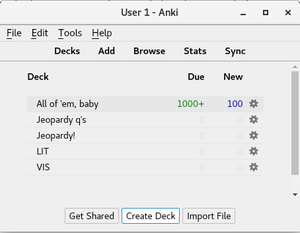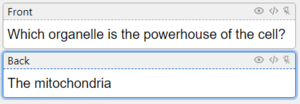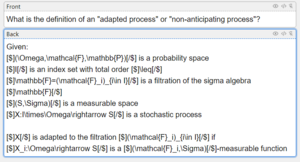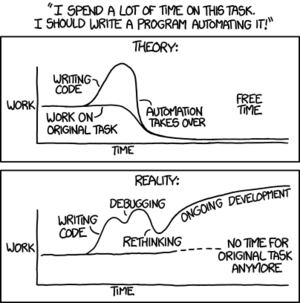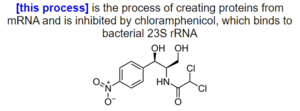Difference between revisions of "How to flashcard"
Kevin Wang (talk | contribs) m (→Overview) |
Kevin Wang (talk | contribs) |
||
| (11 intermediate revisions by the same user not shown) | |||
| Line 55: | Line 55: | ||
===Creating new flashcards=== | ===Creating new flashcards=== | ||
| + | :''See also: [[How to study]]'' | ||
The main goal of carding is to retain pieces of information. This begs the question of "where do these pieces of information come from?" | The main goal of carding is to retain pieces of information. This begs the question of "where do these pieces of information come from?" | ||
| Line 83: | Line 84: | ||
*Correct a factual error | *Correct a factual error | ||
*Mark it as an issue and return to it later | *Mark it as an issue and return to it later | ||
| + | |||
| + | ==Making your first card== | ||
| + | {{Pic|Anki1.png}} | ||
| + | For those who have not carded before, the following is an abbreviated guide to getting started. It should be sufficient for most purposes. | ||
| + | |||
| + | For more in-depth information about techniques, make sure to read the "[[How to flashcard#Tips, tricks, and aphorisms|Tips, tricks, and aphorisms]]" section. | ||
| + | |||
| + | ===0. Acquire information you wish to remember=== | ||
| + | Carding is one step of the process of studying. In general it is more effective if it comes after several earlier stages where one obtains, organizes, and documents the information they wish to learn. This may be short-circuited by grabbing a clue directly from a tossup or bonus - though this is faster, it is less effective in the long term and should be avoided if possible. | ||
| + | |||
| + | Some heuristics for what to write on flashcards in the beginning: | ||
| + | *Focus on simple, concrete relationships where there are few or no ambiguities about the correct answer ("binaries"). | ||
| + | *Aim to incorporate non-trivial information - it should be possible to fail to remember what the backside of a card says. | ||
| + | |||
| + | ===1. Open your carding software=== | ||
| + | As mentioned above, it is strongly recommended that you use a tool with spaced repetition; this guide will focus on [[Anki]]. Nevertheless, these steps should be roughly applicable to other programs (and even physical cards, if that is your preference). | ||
| + | |||
| + | ===2. Create a new deck.=== | ||
| + | It is generally considered better to have a single deck for all cards with a certain purpose. For instance, one might separate cards for learning Spanish from those for cramming for a math test, but aggregate all your quiz bowl-related cards in one deck. To review a specific subset of darks, there are options to "custom study" based on tags; this means it is straightforward at all your cards labeled "literature" or "philosophy" at once. | ||
| + | |||
| + | ===3. Add a card=== | ||
| + | {{Pic|Anki2.png}} | ||
| + | This example will focus on the "Basic" card type - for a discussion of the benefits of different varieties of card, check the section "[[How to flashcard#Learn the types of cards|Learn the types of cards]]". | ||
| + | |||
| + | The "Front" of the card is what is shown - the "Back" is what is concealed. The most straightforward way to write a card would be like a [[bonus]] (or particularly short [[tossup]]): the front has the clues and the back has the answerline. | ||
| + | |||
| + | Some additional tips: | ||
| + | *The desired answer should always be obvious. The card should either incorporate a [[pronoun]] or be phrased in the form of a question. | ||
| + | *Be sure to add tags to cards; these are especially useful for subject-specific studying. | ||
| + | |||
| + | Repeat this as many times as desired. | ||
| + | |||
| + | ===4. Review the new cards=== | ||
| + | Return to the "Decks" view and select the deck with new cards in it. Answer cards until the daily limit is reached (or you grow weary). | ||
| + | |||
| + | Carding software operates on the honor system - the user is expected to self-report whether they remembered the card or not. It does not make any sense to cheat. Giving a higher value demonstrates better retention of a particular card and will produce an appropriately large delay. Low values indicate lapses and often prompt the user for rereview within the next few minutes. | ||
| + | |||
| + | ===5. Adjust settings=== | ||
| + | After completing a review, there are several settings which may be worth changing. | ||
| + | |||
| + | #The number of reviews per day should a comfortable amount - increase it if the current value is easy to complete. If the number ever becomes daunting, lowering it is the best option. Be aware that consistently adding new cards will ultimately require more reviews to get through them. | ||
| + | #Creating an Anki account is necessary to sync cards between different computers, devices, or even people. It is necessary step in using the mobile apps to review on the go. | ||
==Tips, tricks, and aphorisms== | ==Tips, tricks, and aphorisms== | ||
===Learn the types of cards=== | ===Learn the types of cards=== | ||
| − | The simplest possible flashcard is the front-back - a piece of information on one side evokes a piece information on the other. This is likely the format you associate with flashcards, but it is far from the only kind. Knowing the different varieties (or even building your own) can improve your productivity. | + | The simplest possible flashcard is the front-back - a piece of information on one side evokes a piece of information on the other. This is likely the format you associate with flashcards, but it is far from the only kind. Knowing the different varieties (or even building your own) can improve your productivity. |
There is technically a distinction between the ''card that you edit'' (called a "note" in Anki) and the ''cards you review'' (just called "cards"). In general, there is at least one card per note, but the precise mapping will vary from type to type. In most situations this difference does not matter and "card" can be used interchangeably. | There is technically a distinction between the ''card that you edit'' (called a "note" in Anki) and the ''cards you review'' (just called "cards"). In general, there is at least one card per note, but the precise mapping will vary from type to type. In most situations this difference does not matter and "card" can be used interchangeably. | ||
| Line 116: | Line 159: | ||
|- | |- | ||
|style="background-color:rgb(212,212,212)"| '''Cloze deletion''' | |style="background-color:rgb(212,212,212)"| '''Cloze deletion''' | ||
| − | Clozes (''CLOSES'') provide a convenient way to generate a large number of cards from a single note. An arbitrary number of sections of a text can be marked as a "cloze" - for each one, a card will be created that obscures that section and reveals it on the back. | + | Clozes (pronounced ''CLOSES'') provide a convenient way to generate a large number of cards from a single note. An arbitrary number of sections of a text can be marked as a "cloze" - for each one, a card will be created that obscures that section and reveals it on the back. |
The preferred card type of science players. | The preferred card type of science players. | ||
| Line 171: | Line 214: | ||
===Efficiency matters=== | ===Efficiency matters=== | ||
{{Pic|xkcd1319.png|[https://xkcd.com/1319/ xkcd comic 1319]}} | {{Pic|xkcd1319.png|[https://xkcd.com/1319/ xkcd comic 1319]}} | ||
| − | Flashcarding is a long-term strategy - while it can be used for brief, intense study binges, most of its utility comes from its ability to provide results over the course of months | + | Flashcarding is a long-term strategy - while it can be used for brief, intense study binges, most of its utility comes from its ability to provide results over the course of months or years. As such, it is important to try to save time whenever possible. |
Several observations: | Several observations: | ||
| Line 187: | Line 230: | ||
Cards are very good for remembering discrete pieces of information; in particular, they are good at linking precisely two facts together. | Cards are very good for remembering discrete pieces of information; in particular, they are good at linking precisely two facts together. | ||
| − | In quiz bowl, you will access to more than just one piece of information. The same is also true in real life, a place you may have heard of in your studies. In both these places, multiple facts are typically presented at the same time and used simultaneously to arrive at an answer. | + | In quiz bowl, you will have access to more than just one piece of information. The same is also true in real life, a place you may have heard of in your studies. In both these places, multiple facts are typically presented at the same time and used simultaneously to arrive at an answer. |
Don't be afraid to add a few extra pieces of information on a card, or to make them longer if you think it'll aid your long-term retention. It might be hard to judge this while creating a card, but can be assessed more accurately while reviewing. | Don't be afraid to add a few extra pieces of information on a card, or to make them longer if you think it'll aid your long-term retention. It might be hard to judge this while creating a card, but can be assessed more accurately while reviewing. | ||
| Line 198: | Line 241: | ||
*You can't use things that aren't there to learn | *You can't use things that aren't there to learn | ||
| − | The information that ends up written down on any given card | + | The platonic ideal of a card is a single binary association which instantly evokes the entire web of intricate relationships between the front and the back, as well as between each side and every other piece of related information. In practice, cards are written to be longer and explicitly include those connections to aid in retention and ensure that no implicit knowledge is lost in the studying process. Even so, it is important to build up a body of knowledge that isn’t yet on a card (though it may someday end up on one). |
| + | |||
| + | The information that ends up written down on any given card will have been distilled down from this larger initial pool. Some of that will linger in the mind but much is eventually lost to the sands of time. Don't expect to always remember that context later - that's what carding is for, after all. Make the effort to replenish that extra context whenever necessary. | ||
This concept is particularly salient for technical fields like music theory and the hard sciences. It is difficult to test the application of these skills and the intuition that's involved using flashcards. Nevertheless, these are useful skills to cultivate separately, both because of their intrinsic value and their usefulness in retaining your cards. | This concept is particularly salient for technical fields like music theory and the hard sciences. It is difficult to test the application of these skills and the intuition that's involved using flashcards. Nevertheless, these are useful skills to cultivate separately, both because of their intrinsic value and their usefulness in retaining your cards. | ||
| Line 220: | Line 265: | ||
|[[File:ExampleListCard.png|400px]] | |[[File:ExampleListCard.png|400px]] | ||
|} | |} | ||
| + | |||
| + | Another useful tip in the same vein is to intermittently incorporate whitespace - this can aid the eye in focusing on the line with the cloze. | ||
Most cards of a certain length can be formatted in this way; there is often one "primary" fact on any given card. For example, if you are writing a card that describes multiple characters from a novel, the name of the book is the most likely to be an [[answerline]] and thus can act as the subject line. Don't worry too much about how the resulting lines mesh with the sentence's "subject": these are meant to be read as fragments so you will almost certainly not notice. | Most cards of a certain length can be formatted in this way; there is often one "primary" fact on any given card. For example, if you are writing a card that describes multiple characters from a novel, the name of the book is the most likely to be an [[answerline]] and thus can act as the subject line. Don't worry too much about how the resulting lines mesh with the sentence's "subject": these are meant to be read as fragments so you will almost certainly not notice. | ||
| + | |||
This advice is less important in conventional front-back cards. The primary benefit of this structure is to allow relevant parts of a card to be read more quickly, but in the case of the basic card type all of the text is relevant. Hence, restructuring text should only be done if it actually aids your reading process. | This advice is less important in conventional front-back cards. The primary benefit of this structure is to allow relevant parts of a card to be read more quickly, but in the case of the basic card type all of the text is relevant. Hence, restructuring text should only be done if it actually aids your reading process. | ||
| Line 264: | Line 312: | ||
Another useful idea is to have lots of cards which test an association in both directions, either with a reverse front-back card or clozes. Also a good idea. | Another useful idea is to have lots of cards which test an association in both directions, either with a reverse front-back card or clozes. Also a good idea. | ||
| − | One potential issue arises when you combine these two concepts. Imagine that you have just taken notes on an author. You decide to transfer your notes on one of their books into double-sided cards with a single fact on one side and the novel and the author on the other. When you next review your cards, however, you realize that 50% of the cards you just made have the exact same answer! If you then write more cards about a different novel by that author, 50% of | + | One potential issue arises when you combine these two concepts. Imagine that you have just taken notes on an author. You decide to transfer your notes on one of their books into double-sided cards with a single fact on one side and the novel and the author on the other. When you next review your cards, however, you realize that 50% of the cards you just made have the exact same answer! If you then write more cards about a different novel by that author, 50% of your deck will be cards requiring you to identify that author - this is certainly more than optimal. In a related scenario, your deep dive on an obscure author may result in a significant number of your total flashcards asking you to name something that you're confident you will rarely need to remember. |
Getting around this with basic or reverse front-back cards is a bit finicky and requires being careful about how many cards you make for each answerline and varying what you choose to put on the back of your cards. A simpler solution is to use cloze deletions, which will produce cards with a 1:N ratio of "answerline:clue" rather than the 1:2 ratio of a reverse-front back. Rather than 12 notes for 12 clues, you would create a single (or maybe two or three) note(s) which contained all the clues in clozes, reducing the number of times you will have to remember the answerline to a more modest number. Additionally, every one of these new cards will include the answerline in text, so you will still be able to associate it with your clues. | Getting around this with basic or reverse front-back cards is a bit finicky and requires being careful about how many cards you make for each answerline and varying what you choose to put on the back of your cards. A simpler solution is to use cloze deletions, which will produce cards with a 1:N ratio of "answerline:clue" rather than the 1:2 ratio of a reverse-front back. Rather than 12 notes for 12 clues, you would create a single (or maybe two or three) note(s) which contained all the clues in clozes, reducing the number of times you will have to remember the answerline to a more modest number. Additionally, every one of these new cards will include the answerline in text, so you will still be able to associate it with your clues. | ||
| − | Using this solution does mean that your cards will be long and will have other issues of cloze deletions. The former can be mitigated by combining this strategy with the list formatting described | + | Using this solution does mean that your cards will be long and will have other issues of cloze deletions. The former can be mitigated by combining this strategy with the list formatting described [[How to flashcard#Embrace verticality|above]], which can reduce the cognitive load of reviewing them. The latter is, unfortunately, the cost of doing business. |
===Be humble=== | ===Be humble=== | ||
| − | One of the most common (and most flawed) heuristics for assessing a clue is the [[fundamental difficulty error]]: "If I know it, it's easy. If I don't, it's hard." Though there is no objective measure of difficulty, it should be pretty clear that this is not a particularly good way of assessing it. In particular, the moment you learn two pieces of information you may | + | One of the most common (and most flawed) heuristics for assessing a clue is the [[fundamental difficulty error]]: "If I know it, it's easy. If I don't, it's hard." Though there is no objective measure of difficulty, it should be pretty clear that this is not a particularly good way of assessing it. In particular, the moment you learn two pieces of information you may begin to perceive them as the same difficulty to you. Remember, though, that you can write a card on literally any piece of information - that doesn't make that clue "[[stock]]" or "easy". |
When trying to apply your new-found knowledge, whether in the game or outside of it, it may be impossible to remember exactly how hard various things you know are. Best to be cautious and avoid looking like a braggart. | When trying to apply your new-found knowledge, whether in the game or outside of it, it may be impossible to remember exactly how hard various things you know are. Best to be cautious and avoid looking like a braggart. | ||
{{c|Quizbowl documents}} | {{c|Quizbowl documents}} | ||
Latest revision as of 11:38, 5 February 2024
Concepts
Guides
This guide is meant to summarize some specific steps that one can take to effectively flashcard for quiz bowl.
Flashcarding is only one facet of studying and certainly not a requirement for playing, improving, or enjoying quiz bowl - for a broad overview of other approachs, see How to study and read the guides in the "Study" page.
Overview
Flashcarding (henceforth referred to as "carding") is a method of retaining information that is common in quiz bowl. This has not always been the case - the popularity of the technique has seen a steady increase over the last two decades, with players in the early 2000’s relying more on other methods.
There are only a few steps involved in effective carding. In order of importance, they are:
- Reviewing cards with regularity
- Creating new cards
- Amending old cards
There is also a zero-th step, which is "Obtaining a carding program." This guide will start by summarizing each in chronological order from "card creation" to "card retiring".
Many other players have described their personal preferences with carding - you will likely find many of their insights productive to read through. A few are listed here:
- So You Want to Study Quizbowl - the classic guide by Max Schindler
- Re: Help studying by AGoodMan - advice from Jon Suh
- How to Study for Quizbowl - a general guide to quizbowl studying by Nick Dai that spends some time discussing carding
- How to Study Quizbowl Literature using Anki!!! - a video on using clozes to study literature by Towery McNeil
Obtaining a carding program
For many players, the first experience they will have had with flashcards is something they wrote on physical index cards to remember vocabulary words or key terms for one of their classes. Even this rudimentary system is very effective, but its most significant drawback is that it does not scale. As the number of cards increases, the overhead of keeping them organized grows enormously. Quizlet, probably the best-known flashcarding software, allows the creation of digital questions on their website. This solves some of the organizational issues and many players may have started with this instead of physical cards. Both of these will suffice but suffer from the subtle issue that reviewing in order is not as effective as reviewing randomly, and both are less effective than an intelligent spacing.
For this reason, most players will recommend a software that makes use of "spaced repetition". This is a family of algorithms that will delay showing you specific cards that you previously performed well on. There are two major programs which are used for this purpose:
| Anki | Mnemosyne |
|---|---|
|
|
| Shared features | |
| |
It is strongly recommended that you download one of these programs before you start seriously carding.
Downloading either of these free programs takes seconds on a typical internet connection. They are both perfectly acceptable choices - I (Kevin Wang) used Mnemosyne while I was in high school and switched to Anki in college, which I still use today. I would say that the only significant difference is that Anki has an iOS app - $25 well spent.
Creating new flashcards
- See also: How to study
The main goal of carding is to retain pieces of information. This begs the question of "where do these pieces of information come from?"
Typically, carding is a single, typically late, step of a studying pipeline. Clues are obtained from various sources, including packets or reference materials like textbooks, before being written down and eventually converted into flashcards.
It is possible to inherit a deck of cards (from a teammate, from a competitor, from online). You are certainly welcome to use these, but I caution you - the process of creating flashcards can be as significant for retention as reviewing them. It is very hard to beat someone to a fact with a card that they made. For this reason it is also recommended to have at least stage of review and research between learning information and writing it in a card.
Reviewing flashcards with regularity
Regularity is key.
Programs using spaced repetition will schedule specific cards to be reviewed at specific intervals from when they were reviewed - a card that was successfully answered on Tuesday may be scheduled for Friday, while one which took two tries may be slated for tomorrow.
Regularity is key.
Going through all of your due cards every day will ensure the maximum benefit from the algorithm. More practically, if you don't do your reviews one day you'll have to do them the next so try to avoid letting the backlog getting to big.
Regularity is key.
Improvement in any activity is dependent on prolonged, dedicated effort - having a program tell you exactly how much to do each day is just one manifestation of this.
Amending old cards
At every stage of the carding process, it is important to remember that cards are tools meant to improve retention. If you are repeatedly failing to answer a card correctly, it is useful to spend a moment considering whether you truly have not learned the material or if the card has been constructed poorly. Sometimes, it is even appropriate to judge that a card that you wrote is of no utility at all and simply discard it.
Some things you might do to a card in the middle of a review session:
- Add additional clues on the front to give more context
- Give more information on the back to act as a reminder
- Reorder the words to make it easier to parse
- Correct a factual error
- Mark it as an issue and return to it later
Making your first card
|
For those who have not carded before, the following is an abbreviated guide to getting started. It should be sufficient for most purposes.
For more in-depth information about techniques, make sure to read the "Tips, tricks, and aphorisms" section.
0. Acquire information you wish to remember
Carding is one step of the process of studying. In general it is more effective if it comes after several earlier stages where one obtains, organizes, and documents the information they wish to learn. This may be short-circuited by grabbing a clue directly from a tossup or bonus - though this is faster, it is less effective in the long term and should be avoided if possible.
Some heuristics for what to write on flashcards in the beginning:
- Focus on simple, concrete relationships where there are few or no ambiguities about the correct answer ("binaries").
- Aim to incorporate non-trivial information - it should be possible to fail to remember what the backside of a card says.
1. Open your carding software
As mentioned above, it is strongly recommended that you use a tool with spaced repetition; this guide will focus on Anki. Nevertheless, these steps should be roughly applicable to other programs (and even physical cards, if that is your preference).
2. Create a new deck.
It is generally considered better to have a single deck for all cards with a certain purpose. For instance, one might separate cards for learning Spanish from those for cramming for a math test, but aggregate all your quiz bowl-related cards in one deck. To review a specific subset of darks, there are options to "custom study" based on tags; this means it is straightforward at all your cards labeled "literature" or "philosophy" at once.
3. Add a card
|
This example will focus on the "Basic" card type - for a discussion of the benefits of different varieties of card, check the section "Learn the types of cards".
The "Front" of the card is what is shown - the "Back" is what is concealed. The most straightforward way to write a card would be like a bonus (or particularly short tossup): the front has the clues and the back has the answerline.
Some additional tips:
- The desired answer should always be obvious. The card should either incorporate a pronoun or be phrased in the form of a question.
- Be sure to add tags to cards; these are especially useful for subject-specific studying.
Repeat this as many times as desired.
4. Review the new cards
Return to the "Decks" view and select the deck with new cards in it. Answer cards until the daily limit is reached (or you grow weary).
Carding software operates on the honor system - the user is expected to self-report whether they remembered the card or not. It does not make any sense to cheat. Giving a higher value demonstrates better retention of a particular card and will produce an appropriately large delay. Low values indicate lapses and often prompt the user for rereview within the next few minutes.
5. Adjust settings
After completing a review, there are several settings which may be worth changing.
- The number of reviews per day should a comfortable amount - increase it if the current value is easy to complete. If the number ever becomes daunting, lowering it is the best option. Be aware that consistently adding new cards will ultimately require more reviews to get through them.
- Creating an Anki account is necessary to sync cards between different computers, devices, or even people. It is necessary step in using the mobile apps to review on the go.
Tips, tricks, and aphorisms
Learn the types of cards
The simplest possible flashcard is the front-back - a piece of information on one side evokes a piece of information on the other. This is likely the format you associate with flashcards, but it is far from the only kind. Knowing the different varieties (or even building your own) can improve your productivity.
There is technically a distinction between the card that you edit (called a "note" in Anki) and the cards you review (just called "cards"). In general, there is at least one card per note, but the precise mapping will vary from type to type. In most situations this difference does not matter and "card" can be used interchangeably.
| Type | Where this card shines | Pitfalls |
|---|---|---|
| Basic front-back
Your classic, vanilla, milquetoast flashcard. You read one side, think your answer, and flip to see if you're right - bing, bang, boom. The standard, both by default and by convention. Good for most situations. |
This card type is designed to retain simple associations: if A, then B. Basically any fact can also be distilled into this format, but some are particularly well-suited. A few examples:
|
The binary nature of this card type has a tendency to reify things in the mind of the user. Even clues considered "stock" because of their strong associations can actually point to multiple answers when placed in different contexts or examined in more detail, so having cards which don't address this nuance can lead directly to negs.
Avoid this by fleshing out cards with context whenever possible - give extra information on the back or write full sentences on the front. |
| Reverse front-back
One step beyond the basic, this card type can be reviewed in either direction. Each reverse front-back note has two cards - one for the front to back direction and the other for the reverse. |
One becomes good at what they practice - if one only has cards from A to B, it is much harder to go from B to A. These cards are useful for training that reverse direction. | There are very few true "binary associations" in quiz bowl. The classic use case for this card would be "word" and "translation" in language learning and most good uses have a similar pattern. One example use could be "technical term" and "definition".
There has to be enough context on both sides for them both to function, which means twice as much effort per note. |
| Cloze deletion
Clozes (pronounced CLOSES) provide a convenient way to generate a large number of cards from a single note. An arbitrary number of sections of a text can be marked as a "cloze" - for each one, a card will be created that obscures that section and reveals it on the back. The preferred card type of science players. |
The strongest advantage of clozes is that they remove the need to copy-paste information while creating related cards, making them much faster to produce large numbers of. They are an efficient way to create cards that aim to capture how pieces of information interact, as well as for testing long lists of information. Very useful for retaining clues around the clue that the card is focusing on. | Because every card is derived from a single note, slight issues in how the initial text is phrased can make the resulting cards very confusing. This can be mitigated somewhat by adding notes to a cloze to give context, like the pronoun that an answerline would have or a hint. |
| Image occlusion
Conceptually very similar to clozes, but rather than selecting regions of text you select regions of an image. This is typically used for labeled diagrams that combine an image with text. This form of card is supported in both Anki and Mnemosyne, but only through mods (for Anki and for Mnemosyne). |
This card type shares many advantages with clozes, but with one large addition: it is generally harder to manipulate images than text. Clozes can fairly simply be replaced with basic front-back cards, but the same is not true of occluded image cards - it is impractical to achieve the same results that the add-ons provide. | This type of card only works if you have an image on hand which a) is labeled and b) tests something meaningful. |
Some of the flashcard types described above perform similar roles. Two quick examples:
| Short note | Long note | |
|---|---|---|
| Card type | Note(s) | Note(s) |
| Basic Front-Back | 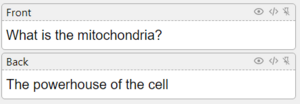
|
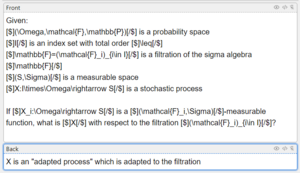
|
| Reversed Front-Back | 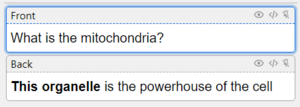
|
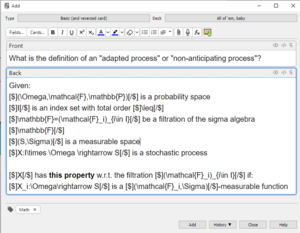
|
| Cloze | 
|
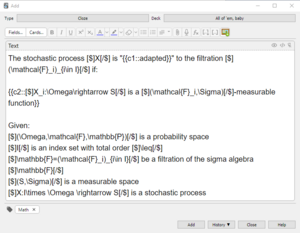
|
The above images were taken in Anki.
Some analysis:
- The basic card type is not well suited for the simple case: it requires roughly twice as many characters as either the reversed front-back card or the cloze.
- The reversed front-back card type is much better at creating this kind of card. The major downside is that there has to be extra context provided for the reverse direction. However, this information also makes it more obvious what is being asked for.
- The cloze shortens the amount of time required to write the cards but at the cost of some confusion, which is clear in the larger.
- In the simple scenario, the reversed front-back is probably the best but none are particularly far behind - even making two basic cards is quick. Clozes are technically the fastest but they're a little confusing to review.
- In the long scenario, the basic card becomes clearer than the reversed front-back and the utility of the back card is so small that one could probably omit it entirely. The cloze does okay, but its real strength begins to shine through this toy example: adding additional cards for other key terms is as simple as editing the card and selecting the new terms. To replicate this behavior with the other card types would be incredibly difficult.
Use images
There are no pictures in quiz bowl (well, not usually) but real life certainly has them. Developing visual associations can help with retention, even if the information is ultimately presented in the form of text.
There are a lot of fields where there are images could obviously add a lot to a card - visual fine arts like painting, sculpture, and film stand out as exemplars - but you may be surprised how much a visual aid can add to a card about a book or a person.
Efficiency matters
| |||
| Above: xkcd comic 1319 |
|---|
Flashcarding is a long-term strategy - while it can be used for brief, intense study binges, most of its utility comes from its ability to provide results over the course of months or years. As such, it is important to try to save time whenever possible.
Several observations:
- In a previous section, cards created using cloze deletion were judged as less robust than simple front-back cards for simple topics but more useful for complicated ones. In both cases, though, creating clozes was faster. Consequently, one could save time by always creating clozes, even when they were not the best choice, and make up for it by creating more cards.
- Both Anki and Mnemosyne allow card templates to be created which can simplify the task of creating cards with specific formations. A potential template for writing questions about chemical reactions could have pre-created fields for the name, reactants, conditions, and products. If a large number of cards with this format were created, the initial time investment would quickly pay for itself.
There is a point where trying to make a task more efficient costs more than just doing it. For instance, you may be tempted to implement your own Anki/Mnemosyne add-on to facilitate your unique workflow. At that stage, it is important to recognize that you've probably crossed the threshold and stop (and perhaps consider a career as an engineer).
Subliminal messaging is bad
The human mind is amazing - you may not believe it, but it is entirely possible (and quite common) to subconsciously remember the exact layout of the text on a card or instantly read words in your peripheral vision. Both of these can be used to recall the answer, but they don't actually require any mental processing. Remember: the goal is not to answer the most cards but to successfully retain the information.
Always try to read through the text of your card and process what it says before you answer.
Play the game
Cards are very good for remembering discrete pieces of information; in particular, they are good at linking precisely two facts together.
In quiz bowl, you will have access to more than just one piece of information. The same is also true in real life, a place you may have heard of in your studies. In both these places, multiple facts are typically presented at the same time and used simultaneously to arrive at an answer.
Don't be afraid to add a few extra pieces of information on a card, or to make them longer if you think it'll aid your long-term retention. It might be hard to judge this while creating a card, but can be assessed more accurately while reviewing.
Know the limitations of cards
There's no way to read beyond what is written on a card. This seems obvious but it bears reminding: no matter how long a card you write (which really shouldn't be that long), the content is very finite.
The implications are two-fold:
- You can't learn things that aren't there
- You can't use things that aren't there to learn
The platonic ideal of a card is a single binary association which instantly evokes the entire web of intricate relationships between the front and the back, as well as between each side and every other piece of related information. In practice, cards are written to be longer and explicitly include those connections to aid in retention and ensure that no implicit knowledge is lost in the studying process. Even so, it is important to build up a body of knowledge that isn’t yet on a card (though it may someday end up on one).
The information that ends up written down on any given card will have been distilled down from this larger initial pool. Some of that will linger in the mind but much is eventually lost to the sands of time. Don't expect to always remember that context later - that's what carding is for, after all. Make the effort to replenish that extra context whenever necessary.
This concept is particularly salient for technical fields like music theory and the hard sciences. It is difficult to test the application of these skills and the intuition that's involved using flashcards. Nevertheless, these are useful skills to cultivate separately, both because of their intrinsic value and their usefulness in retaining your cards.
Prepare for lapses
Though consistency is important, there are a ton of reasons that you may not fill your daily review quota (or miss a day entirely). A great reason is "that you don't want to review that day" - prioritizing mental health and avoiding burnout is a very important part of a study routine.
It often feels like you are seeing your cards for the first time after some time away. Make it easy for yourself by fleshing out your cards, either when you are first creating them or when you're reviewing them again. The biggest thing to include is that every card lists the pronoun of the answer: "this book", "this author", "this molecule". If you're using clozes, the hint functionality is your friend.
Embrace verticality
When writing cards with clozes, it is tempting to always write full sentences or to use paragraphs. This becomes unwieldy, especially for cards with a large amount of content, as it becomes difficult to identify what parts of the card contain relevant information for filling in the deleted cloze.
An alternative format is placing the subject first and all the clauses on separate lines underneath it. The act of splitting up a block of text into shorter sections reduces the amount of scanning that's necessary to determine the context of a given cloze, especially if each clause discusses distinct information.
An example:
| Before | After |
|---|---|
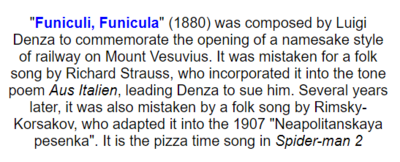
|

|
Another useful tip in the same vein is to intermittently incorporate whitespace - this can aid the eye in focusing on the line with the cloze.
Most cards of a certain length can be formatted in this way; there is often one "primary" fact on any given card. For example, if you are writing a card that describes multiple characters from a novel, the name of the book is the most likely to be an answerline and thus can act as the subject line. Don't worry too much about how the resulting lines mesh with the sentence's "subject": these are meant to be read as fragments so you will almost certainly not notice.
This advice is less important in conventional front-back cards. The primary benefit of this structure is to allow relevant parts of a card to be read more quickly, but in the case of the basic card type all of the text is relevant. Hence, restructuring text should only be done if it actually aids your reading process.
Bad cards produce bad buzzes
In computer science, the phrase "garbage in, garbage out" is used to describe the results of providing low quality or otherwise flawed data into a system. The principle holds true in many domains.
There are a lot of ways that a card can end up failing at its job. Some examples of bad cards:
| A bad card | Explanation | A better card | Explanation |
|---|---|---|---|
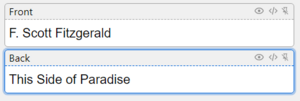
|
This card suggests that if a player hears "F. Scott Fitzgerald", they should assume the question is referring to the novel This Side of Paradise. This is a faulty association on several levels:
|
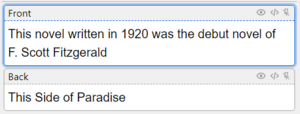
|
This card now gives a pronoun and uniquely identifying information. |
There are a few subtle issues with this card:
|
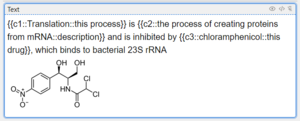
|
|
Learn the shortcuts
| |||
| Above: xkcd comic 1205 |
|---|
Anki has various keyboard shortcuts - Mnemosyne does as well. Learn them and learn them well - saving a second every time you type in a cloze or put text in bold saves huge amounts of time over hundreds (or thousands) of notes.
Be careful of cardinality
A natural inclination is towards short cards which have one or two clues and then the desired answer. This is a good idea.
Another useful idea is to have lots of cards which test an association in both directions, either with a reverse front-back card or clozes. Also a good idea.
One potential issue arises when you combine these two concepts. Imagine that you have just taken notes on an author. You decide to transfer your notes on one of their books into double-sided cards with a single fact on one side and the novel and the author on the other. When you next review your cards, however, you realize that 50% of the cards you just made have the exact same answer! If you then write more cards about a different novel by that author, 50% of your deck will be cards requiring you to identify that author - this is certainly more than optimal. In a related scenario, your deep dive on an obscure author may result in a significant number of your total flashcards asking you to name something that you're confident you will rarely need to remember.
Getting around this with basic or reverse front-back cards is a bit finicky and requires being careful about how many cards you make for each answerline and varying what you choose to put on the back of your cards. A simpler solution is to use cloze deletions, which will produce cards with a 1:N ratio of "answerline:clue" rather than the 1:2 ratio of a reverse-front back. Rather than 12 notes for 12 clues, you would create a single (or maybe two or three) note(s) which contained all the clues in clozes, reducing the number of times you will have to remember the answerline to a more modest number. Additionally, every one of these new cards will include the answerline in text, so you will still be able to associate it with your clues.
Using this solution does mean that your cards will be long and will have other issues of cloze deletions. The former can be mitigated by combining this strategy with the list formatting described above, which can reduce the cognitive load of reviewing them. The latter is, unfortunately, the cost of doing business.
Be humble
One of the most common (and most flawed) heuristics for assessing a clue is the fundamental difficulty error: "If I know it, it's easy. If I don't, it's hard." Though there is no objective measure of difficulty, it should be pretty clear that this is not a particularly good way of assessing it. In particular, the moment you learn two pieces of information you may begin to perceive them as the same difficulty to you. Remember, though, that you can write a card on literally any piece of information - that doesn't make that clue "stock" or "easy".
When trying to apply your new-found knowledge, whether in the game or outside of it, it may be impossible to remember exactly how hard various things you know are. Best to be cautious and avoid looking like a braggart.

